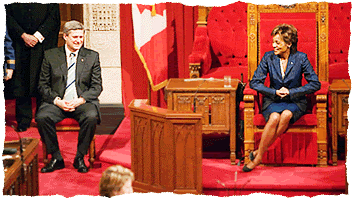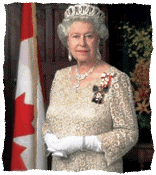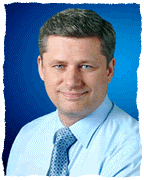
Her Excellency, the Right Honourable Michaëlle Jean, Governor General of Canada, after granting Royal Assent December 12, 2006

Her Excellency, the Right Honourable Michaëlle Jean, Governor General of Canada, after granting Royal Assent December 12, 2006
Canada is a constitutional monarchy. This means that all authority originates from the Crown. However, the powers of The Queen (who is sometimes referred to as the Sovereign or the Monarch) are subject to the country's basic law, the Constitution. It also means that decisions about policy on a day-to-day basis are made by those whom Canadians elect to office, as is normal in a parliamentary democracy.
The Crown
The Queen
usually refers to the person who is Canada's Monarch. Since 1952, this is Her Majesty Queen Elizabeth II. The Crown
is the term used to refer to the legal authority which the elected government possesses, and which it exercises in the name of The Queen.
Canada's Sovereign is one of the best known and respected individuals in the world. Carrying out many of her responsibilities on a day-to-day basis are the Governor General (for the nation), whom The Queen appoints on the nomination of the Prime Minister, an the Lieutenant Governors (one for each province). Each is head of the formal executive of Canada or a province. See below for text of the Royal Proclamation constituting The Office of Governor General of Canada.
As the embodiment of Canada, The Queen is popularly known as Canada's Head of State.
Serving for life from the time of her predecessor's death, The Queen represents and works on behalf of the value on which all Canadians agree: fostering pride in national identity, following the rule of law, building a sense of community, recognizing outstanding achievement, encouraging tolerance, volunteerism and the value of the family.
On the other hand, the Prime Minister is usually the leader of the political party which has the greatest number of seats in the House of Commons. He is properly called Head of Government.
His role is necessarily often controversial: it is his job to make decisions and argue for his beliefs about matters about which Canadians disagree, ranging from gun control to abortion, from health care to capital punishment. His decisions, and the performance of the government he leads, are regularly tested by the election process, which the Constitution requires take place at least every five years.

Queen Elizabeth II is Canada's Head of State

Stephen Harper is Canada's Head of Government
The Parliament of Canada consists of The Queen, the Senate and the House of Commons. Agreement of all three elements is necessary before a bill (a piece of legislation) becomes law, an Act of Parliament. Except in extraordinary circumstances, Royal Assent is routinely given to all bills passed by the Senate and House of Commons, since the legislation reflects the consensus of those who have been elected to govern the country.
Canada is also a federal state. This means a form of government where certain powers are held by the national government, based in Ottawa, while other powers are held by each of the provincial governments, based in their different provincial capital cities. For example, laws about banking or the Criminal Code are made by the Parliament of Canada, while laws about education and municipal affairs are made by the provincial legislatures. This federalist identity means that in Canada there are actually 11 Crowns — usually referred to as The Crown in right of Canada
and The Crown in right of (name of Province).
The word prerogative
refers to some power which the holder has the right to exercise. The Royal Prerogative is the body of powers, many existing by custom rather than by legislation, which the Sovereign may exercise in the interest of Canada.
Most of these powers are normally used only on the advice of the Prime Minister of Minister of the Crown; these include granting pardons to criminals, withholding a passport and either calling Parliament to meet or dissolving it so that an election can be held. Custom rather than law usually requires the Sovereign to ask the leader of the largest party to form a government as Prime Minister, and to assent to the Prime Minister's constitutional Advice
in respect of the life of a Parliament, appointment of Cabinet Ministers and approval of Orders-in-Council.
These are the detailed Regulations made by the government to carry out the purpose of legislation.
Other Prerogative powers include creation of new Honours (such as the Order of Canada) and Decorations (such as the South-West Asia Service Medal), approval of the use of the Royal Crown in Canadian Heraldry and the granting of the title Royal
and Royal Patronage to different prominent institutions such as schools, cultural organisations and military bodies.
Many powers granted the Sovereign, either by custom or through the Constitution, are usually not independently exercised by the Monarch: dismissing a Prime Minister, dissolving a Parliament, and refusing Royal Assent to a bill passed by Parliament. However, they remain legally in full effect, in case normal democratic processes should break down and a neutral, non-partisan source of authority must act in the capacity of what the journalist Michael Valpy has called a national fire extinguisher.
Contrary to belief, Canadian taxpayers do not support any of the expenses of The Queen's Private Office and Residences in the United Kingdom. Naturally, when the Sovereign comes home to Canada, expenses of travel and entertainment are the government's responsibility. The normal cost of the Canadian Crown is about $1.25 per citizen annually. This amount is spent in maintaining the historic residences that provide a base for the Governor General and Lieutenant Governor and that are used for many occasions, in travel for these vice-regal representatives of The Queen and in providing recognition and hospitality for visitors and those Canadians being honoured for their contributions to society.
One of the ways in which The Queen recognizes Canadians who have shared extraordinary service, talent or bravery with their country or community is through a system of Honours. Every element of the Honours System in Canada is approved by The Queen, and many bear her image on Decorations and Medals. Canadian Honours range from the Order of Canada and the Order of Military Merit to Campaign Medals awarded to members of the Canadian Forces. Each province also has established a similar system of Honours.
The King or Queen of Canada is also Sovereign of the United Kingdom and some 15 other Commonwealth countries called Realms
to distinguish them from the Commonwealth republics which acknowledge The Queen as Head of the Commonwealth but have their own Head of State.